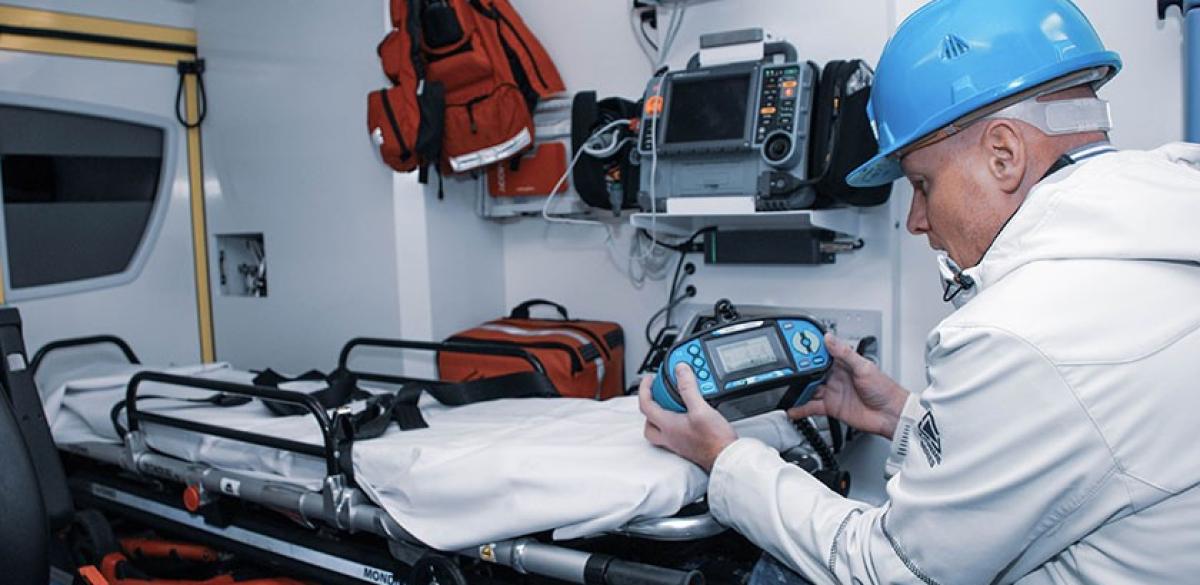Ambulances
Secondary power sources in healthcare

An ambulance is a combination of automotive, medical and utility technology, all tightly fitted in the smallest possible space, and with human lives depending on it. Electrical functionality and safety of each part must be established frequently and with highest possible confidence.
First part of ambulance functionality is plain movement. Modern vehicles contain, apart from traditional vehicle electrics, also a large amount of electronic tools and aids for keeping it on the road in any condition. There are automatic systems checking their functionality, while electrical safety is inherent due to their low operational voltage. The only danger they pose is failing unexpectedly. It is the manufacturer’s responsibility to create effective fail-safes and checks.
Medical devices on board are about preserving life. They must be scaled to lowered power of the supply. Ambulances can be equipped with an extra generator to providing higher supply voltages, or with extra batteries and a powerful inverter. In both cases, maximum available power is much more limited than in a fixed supply. All equipment has to be adapted to such use, or be low-powered in the first place. The same goes for measuring instruments for keeping the medical devices in shape. Battery powered and handheld versions have a strong advantage for both power and space. Other devices are utility. From lighting to fridge for medicines or food on the way, they make ambulance work possible. They can mostly work either from the 12 V car battery or the higher voltage generator. Testing equipment for them has to take this into account.
Currents are too low to cause notable cross-talk or other wireless effects. Power quality of the output from the generator then almost exclusively depends on the inverter quality, while DC from the car battery is by definition a bit variable. Devices that run on it must be able to tolerate voltage between about 10 and 14 volts. A good quality inverter will have output filters to output nice single-frequency sine signal, or a good-enough approximation. However, cheaper types may not; their output is nearly perfectly rectangular, full of higher harmonics, and troublesome for supply of any sensitive device. They can be adequate for some devices that contain input filters, or are quite insensitive to harmonic content.
Ambulances can be designed for this purpose from scratch, or they can be adapted from a different vehicle. Field tests showed that adapted vehi-cles are often less reliable and their electrical integrity is questionable. They absolutely should be tested periodically and after every deployment. Designed from scratch vehicles are considered the more reliable choice. A brief check-up after deployment and a thorough test at manufacturer-advised intervals should keep it running properly.
Application Notes
Measurements
Measurements are very similar to testing in isolated systems. However, instruments will often be exchanged for their smaller, more portable variants that allow the garage crew to move from one vehicle to the next fast and easily. Portability is also extremely important if the instrument is carried aboard, which may be beneficial to do. MI 3110 is the basic instrument for testing the higher voltage installation in the vehicle. It measures insulation, line impedance and voltage parameters in an Autosequence®. Lower voltages can be tested simply with a multimeter with a clamp, like MD 9231. Basic safety of devices can be established with MD 3309 DeltaPAT. It can measure insulation, continuity with 200 mA and leakage currents. It doesn’t support extra measurements for medical devices, so they have to be tested separately and possibly outside the vehicle. Autosequence®s with guides to visual inspection can be created by request in any Metrel instrument and therefore the most important part of the safety is covered.

















